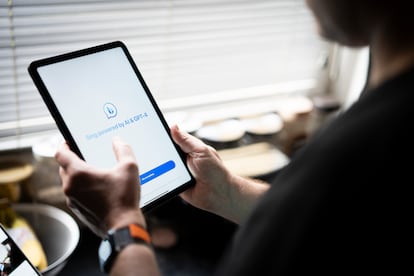ChatGPT, Llama, Bard and Bing: Who’s who in the conversational chatbot race
Meta just launched a new model for programmers to use instead of the paid versions offered by OpenAI and Microsoft

The planet’s leading technology companies are engaged in a commercial chatbot race. The advent of ChatGPT, developed by OpenAI, has changed human interactions with artificial intelligence (AI), triggering an unprecedented revolution around the world. Its debut in late 2022 and undeniable success since then has forced tech giants to compete to offer the most advanced and versatile solutions. Meta has its chatbot, Llama 2, and just introduced Code Llama, designed specifically for programmers who write code and can capture customers using Microsoft’s or OpenAI’s paid models. Google also has its own conversational robot that speaks in the first person, impersonates humans and performs the most creative tasks.
Although Apple has not confirmed its version, that does not mean that it has sat out the competition. According to Bloomberg, the Cupertino-based company is testing generative artificial intelligence internally, indicating that it may have plans to include it in its most popular products, such as the iPhone and iPad.
ChatGPT, the first and most powerful
ChatGPT, OpenAI’s text-generating AI chatbot, ushered in the era of conversational chatbots, and within five days of its launch, it already had more than one million users. Version GPT-3.5 is free to use and capable of writing essays, translations, code, poems and more from short text prompts. It can also answer questions informatively, even open-ended or peculiar inquiries. But it only gathered information until 2021, so it is not capable of generating or evaluating current information.
Users who pay $20 per month (about €18) have access to GPT-4, the more powerful version that communicates more naturally and fluidly than the free model and is also better at writing programming code. Among the significant improvements, it connects to the internet, captures irony and can produce text that is indistinguishable from text written by humans. In addition, paid users have access to the chatbot even during peak usage, when the platform’s free version stops working.
Meta: Llama 2 and Code Llama
With Llama, Mark Zuckerberg’s company Meta has forged its own path in the artificial intelligence race. Initially, this model was reserved for guest researchers, until it was leaked on the 4chan forum just a week after its launch. In mid-July, Zuckerberg launched Llama 2, the main partner of which is Microsoft. It is a trained version with 40% more data and connects to the internet.
Llama 2 represents a turning point in the field of artificial intelligence because, as an open-source platform, it allows companies to create their own applications for free. In addition, on Thursday the company went public with Code Llama, a programmer-optimized option that promises to “lower the barrier to entry for people learning to code,” as the company put it. Because it is free, it could have an even greater impact on competition by dissuading users from opting for paid assistants, such as Microsoft’s GitHub Copilot, which operates using OpenAI technology.
Today we’re releasing Code Llama, a large language model built on top of Llama 2, fine-tuned for coding & state-of-the-art for publicly available coding tools.
— Meta AI (@MetaAI) August 24, 2023
Keeping with our open approach, Code Llama is publicly-available now for both research & commercial use.
More ⬇️
Users who want to download both models, Llama 2 and Code Llama, can apply on the website, but immediate access is not available. However, Llama 2 can be tested in chat form in this Perplexity Labs development. Meta claims that the model is trained using publicly available online data, but its results appear to be inferior to those of its competitors. Among its bugs, it randomly switches languages to English. Despite criticism, the company is confident in its collaborative approach, although there are concerns about what might happen if it ends up in the hands of bad actors.
Google: Bard and Workspace
Google’s Bard is free. To use it, one just needs to have an account with the company (the same one used for Gmail or Drive). Like ChatGPT, it provides multiple answers to a single question, but it also has greater versatility: beyond writing texts, it can read aloud, similar to the extant function in Google’s popular translator. And the generated answers can be forwarded to Gmail or Docs and shared through a public link.
A major difference compared to GPT-3.5 is its access to up-to-date information. While the free version of OpenAI has information through 2021, Bard draws from fresh information on the web. In addition, it tracks the source of its responses, and the user can access it directly from a link in the chat.
Conversational chat is not Google’s only offering. The company has also unveiled new updates to Workspace, its business tool. New features will allow for summarizing and responding to long email threads, turning those conversations into reports, and even making slides of the reports. According to the company, it will also provide the ability to customize dozens of messages in a spreadsheet. To date, only a few companies have been able to test the new features.
Microsoft: Bing and Copilot
Microsoft is involved on almost all fronts. It has a partnership with Meta for Llama 2 and is the major investor in OpenAI (with an investment of $10 billion). But it also has its own conversational chat model: Bing, the revamped version of its search engine, includes information from the internet, presents the sources of its answers, which can then be exported in Word, PDF or text format. The company hopes to draw from Google’s market share, although it has some limitations. For example, it only answers up to five questions in a single thread. When that limit is reached, a new chat must be started.
On the other hand, among its advantages over Bard, Microsoft’s offering stands out for its ability to conduct more sophisticated searches, on some occasions. For example, when asked to recommend a restaurant available on a specific date, Bing not only presents the relevant names, but also their respective websites to make a reservation, while Bard is limited to providing just the names.
For the corporate world, the company has presented Microsoft 365 Copilot, a solution analogous to Google’s Workspace but as part of the Office package, which includes popular tools like Word, Excel and PowerPoint. At the moment, one must be a member of Windows 11 Insider — an exclusive program to which business customers are invited — to access the resource. It is not yet known when Microsoft 365 Copilot will be available to the general public.
Apple’s unknown chatbot
Apple appears to be pursuing a more cautious strategy. Last June, it announced its use of artificial intelligence to improve autocorrection and dictation in iOS 17, indicating a more modest approach than its competitors. The company even avoids mentioning terms like GPT, AI and advanced language models in its presentations. However, as reported by Bloomberg, Apple is using a tool similar to ChatGPT internally to help its employees in their jobs. In the meantime, the company is considering implementing such technology in its products; according to rumors, the chatbot is called Apple GPT. With this innovation, Apple users could employ conversational capabilities directly in iOS, iPadOS, macOS and watchOS, which would be accessible with their Apple ID, without having to download third-party apps.
Sign up for our weekly newsletter to get more English-language news coverage from EL PAÍS USA Edition
Tu suscripción se está usando en otro dispositivo
¿Quieres añadir otro usuario a tu suscripción?
Si continúas leyendo en este dispositivo, no se podrá leer en el otro.
FlechaTu suscripción se está usando en otro dispositivo y solo puedes acceder a EL PAÍS desde un dispositivo a la vez.
Si quieres compartir tu cuenta, cambia tu suscripción a la modalidad Premium, así podrás añadir otro usuario. Cada uno accederá con su propia cuenta de email, lo que os permitirá personalizar vuestra experiencia en EL PAÍS.
¿Tienes una suscripción de empresa? Accede aquí para contratar más cuentas.
En el caso de no saber quién está usando tu cuenta, te recomendamos cambiar tu contraseña aquí.
Si decides continuar compartiendo tu cuenta, este mensaje se mostrará en tu dispositivo y en el de la otra persona que está usando tu cuenta de forma indefinida, afectando a tu experiencia de lectura. Puedes consultar aquí los términos y condiciones de la suscripción digital.
More information
Archived In
Últimas noticias
EU’s prestige at stake with proposal to fund Ukrainian war effort with Russian assets
Mustafa Suleyman: ‘Controlling AI is the challenge of our time’
Venezuela breaks energy agreements with Trinidad and Tobago due to alleged complicity with the US
The murder of Michele and Rob Reiner: A tale of horrific days in Hollywood
Most viewed
- ‘El Limones’ and the growing union disguise of Mexican organized crime
- Christian Louboutin: ‘Young people don’t want to be like their parents. And if their parents wear sneakers, they’re going to look for something else’
- ‘We are dying’: Cuba sinks into a health crisis amid medicine shortages and misdiagnosis
- A mountaineer, accused of manslaughter for the death of his partner during a climb: He silenced his phone and refused a helicopter rescue
- The low-cost creative revolution: How technology is making art accessible to everyone











































